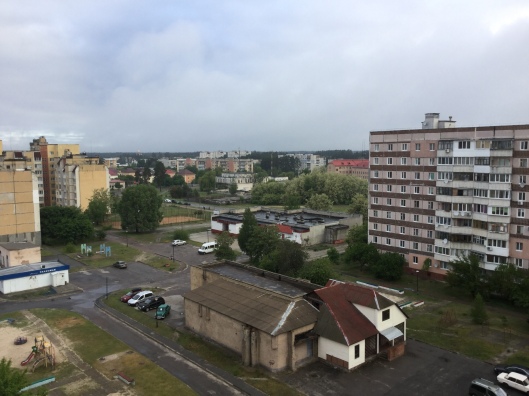Tags
Amphibians, Biology, Chernobyl, Ecology, Fieldwork, frogs, Radioecology, Research, Science, Ukraine, Wildlife, Zoology
21 May 2018
Today it was a transition day for us here in the #ChernobylFrogs18 research project. After expending a full week inside the Chernobyl Exclusion Zone collecting treefrogs for our studies, it was time to move out and try catching frogs in areas never affected by the radioactive fallout after de 1986 accident in the Chernobyl Power Plant. So, we move to the east, to the city of Slavutych.

As usual, we started the day working in the lab obtaining samples from the 11 frogs collected the previous night. These frogs put our total for the trip, so far, in 90 frogs collected in six different localities inside the Exclusion Zone, two from high radiation area, one from medium, and three from low radiation levels. This is a great number, especially considering that the season this year is well advanced due to the intense warm in early spring, and that the weather was a bit colder than ideal. At least weather wasn’t like last year with temperatures barely over zero!!

Our job in the lab was very quick, the more days they pass the faster we go. We tried something new to communicate what we do here and used Twitter combining the hashtags #ChernobylFrogs18 and #liveScience to transmit live our work in the lab, resulting in 17 tweets. It was a fun experience, let’s see if it is possible to repeat something similar today from the field…

As usual, Sergey was in charge of the radiometer, measuring the radioactive content of our frogs, whereas Pablo, Jean-Marc and I, got the physiological and genetic samples from all the frogs.

We finished for lunch time, and quickly packed all our equipment again, from the tubes and scissors, to the cameras and the portable lamps. Everything needed for our work. This included also our dry shipper, refilled with more liquid nitrogen and very, very, full of samples. After waiting a while for our van, we moved to the main checkpoint of the Exclusion Zone. Our car was checked for radioactive contamination, our luggage was checked for radioactive contamination, and we were also checked for radioactive contamination. Our paperwork was in order, all permits stamped and approved. All clear, all fine. We passed the detection archs for radioactive contamination and out!!

Our drive from Chernobyl to Slavutych was a long, jumpy, drive. This drive usually takes 45 minutes by the direct road crossing Belarus, but due to bureaucratic issues it was impossible for us and our equipment and samples. We had to go all the way around to avoid crossing Belarus. At that means a 4 hour drive, first South to the outskirts of Kiev, and back North towards Slavutych. This was the bumpiest drive we have ever had, for kilometers and kilometers we were jumping like monkeys inside the van. It was even difficult to hear each other in the middle of the noise. Not the most confortable drive, really not. On Friday, we will do part of this drive again in our way to the airport… Anyway, on arrival it was Sergey waiting for us to show us our apartment for these days in Slavutych, and we finally drove through the city to a local restaurant in which we had an amazing dinner!!

Even better, after a full week of movement restrictions inside the Chernobyl Exclusion Zone, we were able to move freely through the city in our way back to the apartment!! Back to the free world!!
Our plan for today is going to explore areas near Slavutych and Chernihiv, looking for potential good places for frog sampling during the night. Weather forecast, again, is not super good, although it should improve during the day and the rest of our time here. It will be challenging trying to find a good place for treefrogs without much previous knowledge, but the area looks good and the search will be exciting, no doubt. Let’s see…
